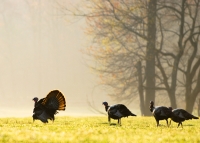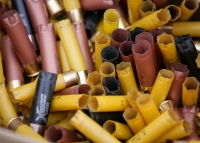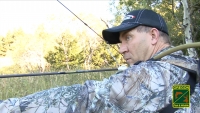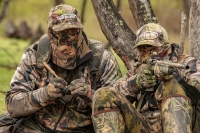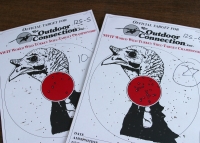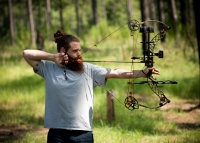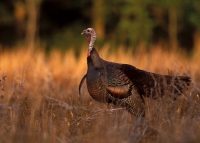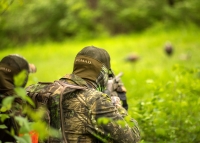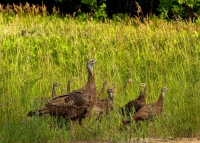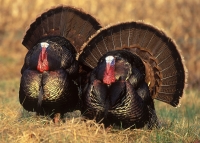
Selecting guns and ammo
Selecting a shotgun for turkey hunting
If you're currently a bird hunter – upland or waterfowl – chances are you already have a shotgun you can use for turkey hunting. If you’re a new hunter, here are some tips for buying a shotgun.
The most important features to look for when buying any shotgun are:
- Fit. Differences in the size and shape of the stock and butt, mean different shotguns “fit” differently. Spend some time shouldering a number of different weapons and brands to see which fits you the best.
- Handling. Select a shotgun that you can shoot well. This includes gun fit, but also recoil. If the recoil is so great it influences your second shot, select a different action or a smaller gauge.
When buying a new gun for turkey hunting, or even assessing the appropriateness of you current gun, here are the things to consider:
Action
- A pump action shotgun requires manually sliding a pump backwards and forwards (cycling) in order to chamber a shell. Once a round is chambered, simply pull the trigger to fire a shot. Then cycle the pump to expel the empty shell and insert another.
- A semiautomatic shotgun instantly and automatically cycles a shell each time you pull the trigger. This means you can fire a second shot as fast as you can pull the trigger a second time. These guns tend to be "softer" shooters than a pump, because a semiautomatic shotgun diverts the gun's recoil to cycle the next round, meaning less perceived recoil for the shooter.
Both pump and semi-automatic shotguns can be equally effective for hunting turkeys, but each has advantages (and disadvantages) over the other. If price is a primary consideration, you may choose a pump. If you have a smaller frame or are buying for a youth, you may choose a more expensive semi-automatic that will be softer and more comfortable to shoot.
Pump vs. semi-automatic actions
Pump action |
Semiautomatic |
|
more affordable |
more expensive |
|
durable, reliable |
can jam when ejecting shells |
|
more recoil |
less recoil |
|
must manually cycle action for second shot |
automatically cycles action for second shot |
Gauge
In shotguns, the smaller the number, the bigger the gun or gauge. A 10 gauge shotgun has a bigger bore than a 12 gauge shotgun, which is bigger than a 20 gauge shotgun. Also, the larger the gun, the bigger the shotgun shells – meaning more pellets and gunpowder.
But larger guns create more recoil (kickback) and can be uncomfortable for some to shoot. Choose a gauge you can shoot comfortably during longer practice sessions at the range, and not just when you take a single shot at a turkey.
12 gauge shotguns
- Most popular
- Larger shells -- more pellets and gunpowder
- More available shell sizes and load options
- More recoil
20 gauge shotguns
- Less recoil – more comfortable to shoot for youth and adults with smaller frames
- Fewer available shell sizes and load options
- Big enough to kill turkeys
What about a 10 gauge?
You can use a shotgun as big as a 10 gauge to hunt turkey in Oregon. And that used to be a popular weapon for turkey hunting. However, advances in 12 gauge shells – including 3-inch and 3 ½-inch shells – have made the 10 gauge obsolete for most applications. Besides, they kick like a bear.
Length
Many turkey hunters prefer a shorter barrel length (22-26 inches) to maneuver in a blind or heavy cover.
Sights
Most turkey hunters prefer a better sight on their shotgun than the typical one or two metal beads on top of the barrel. Turkeys are normally a stationary target – unlike a flushing pheasant or a decoying duck – and ideally you want to shoot them in the head for a clean kill that doesn’t spoil the meat. That’s a pretty small target you’re aiming at.
Here are two popular kinds of sights to help you acquire your target and shoot accurately:
- A fiber optic sight is brighter than a metal bead, making it easier to locate the sight and line it up with the head of a turkey. Many shotguns designed for turkey hunting come with a single fiber optic sight mounted on the front of the barrel. You also can buy aftermarket fiber optic sights to install on the gun you already have, as long as it has a ventilated rib and metal bead on top of the barrel. Popular colors are orange, yellow or green.
- A red dot sight contains an illuminated dot inside a sight housing. These are considered the most accurate sights for turkey hunting. A red dot sight is typically very low power; some have no magnification. Some need a battery to operate, some don't. In Oregon, a battery-operated sight or scope is legal on a shotgun as long as it doesn't project a beam onto the target.
Other considerations
- Color. A matte black gun is fine if you're shooting from a blind. But if you’ve set up in natural cover, you might appreciated the extra concealment of a camo-colored gun. Many dedicated turkey and waterfowl guns come in camo, which costs a bit more. In addition, there are a variety of tapes and other aftermarket materials you can use to camouflage your existing gun.
- Recoil pad. Almost all shotguns come with some sort of recoil pad – a rubber or plastic attachment at the end of the stock that helps absorb some of the recoil. There are aftermarket recoil pads that do an even better job at making shooting more comfortable. Buying one doesn’t make you a sissy.
Selecting shotgun shells and chokes
The variety of available shotgun shells can be dizzying, and there are more being introduced all the time. But taking into account the size of your shotgun and your intended target will help you narrow the choices to a more manageable number.
Where to find shell information
When you buy shells, the box they’re in will be labeled with the gauge, shell length, amount of shot inside the shell (in ounces), the size of shot and how many feet per second the load travels. Some of this information may also be printed on each shell to help you identify loose shells.
Buy shells to fit your gun
Select shells that are the right gauge and length for your gun.
- Match the gauge of the shells to the gauge of your gun. For example, a 12 gauge gun takes 12 gauge shells. You CANNOT use a shell that’s a different gauge than your gun, even if the shell fits into the chamber of the gun.
- Buy the correct length shells. Shell length is measured in inches. The maximum shell length will be engraved on the barrel of the gun. That is the longest shell you can shoot with the gun, but you can always shoot a shorter shell.
For example, if your older gun is chambered for a 2 ¾-inch shell, you cannot use a 3-inch shell. However, if your gun is chambered for a 3-inch shell, you can use a 2 ¾-inch shell.
Pick suitable shot sizes
"Shot" refers to the pellets within a shell. Pellets come in different sizes depending on what they’ll be used for – the smaller the pellet number, the larger the pellet. Weird, huh?
Shooters might use shot as small as #9 for very small birds like quail, or as large as #2 for large birds like geese and swans. For comparison, there are 585 #9 lead pellets in an ounce versus only 90 #2 pellets in an ounce.
For turkey hunting, shot sizes 4, 5 and 6 will all work.
Size and velocity vs. recoil
Though turkeys are big birds, the target area (head and neck) is relatively small. Having a high energy load with a tight shot pattern is key to a clean kill. However, there are trade-offs between the having most and biggest pellets, the longest shells and the fastest velocity, and recoil.
Many newer turkey-specific loads come in long 3 ½-shells, with velocities up to 1,400 feet per second, and are designed to be used with specialized turkey chokes. These high-powered loads will kill a turkey but can be difficult and uncomfortable for some hunters to shoot.
It will take some trial and error to find the right shells for you and your gun. We’ll go over this more when we talk about patterning your shotgun.
Chokes
By definition, a choke is a tapered constriction that shapes the spread of the pellets as they leave the gun. A less-constricted choke throws a wider patter, and a more-constricted choke shoots a tighter pattern.
Some older shotguns have fixed chokes that are an integral part of the barrel. Most newer guns come with a selection of interchangeable chokes that look like small metal tubes and screw into the muzzle. The amount of constriction varies among the chokes tubes, allowing a hunter to change how their gun shoots based on what they’re hunting.
For a big, stationary targets like turkey, a full choke is the best choice and is usually included with the purchase of a new shotgun. This choke concentrates the pellets into a small pattern, ensuring more pellets hit the target zone (the turkey's head).
There also are specialized turkey chokes that are extra-full. These chokes shoot a dense, narrow pattern that may be more effective at longer distances.
Firearm safety
Hunting involves a deadly weapon that can kill more than just your target. Hunting and handling your gun safely MUST be a top priority.
Start with the fundamentals
Start by learning these four gun safety fundamentals and you’ll be well on you way to a lifetime of safe hunting.
- Assume all guns are always loaded. The primary benefit of handling all guns as if they were loaded, is that it will help you develop safe gun handling habits.
- Never let the muzzle of the gun (the shooting end) point at something you’re not willing to shoot. Often referred to as “muzzle control.” This also means carrying your gun so it’s not pointing at someone, and not swinging the muzzle through a person as you mount the gun to take a shot.
- Keep your finger off the trigger and out of the trigger guard until you’re ready to shoot. This can be harder than it sounds because most of us have a natural inclination to put our finger on the trigger whenever we pick up a weapon. Instead, teach yourself to rest your index finger straight along the side of the receiver until you’re ready to shoot.
- Be sure you’ve correctly identified your target (is that a gobbler or hen turkey, or even a decoy), and know what’s behind it. Your shot may miss, or pass through the target, so make sure there’s nothing behind it that you don’t want to shoot.
Consider taking a hunter education
If you’re new to hunting, a hunter education class can be a great way to learn about, and PRACTICE, hunting safety concepts.
Hunter education is required for hunters younger than 17, but plenty of adults take it, too. You can take a course in person, online or with a workbook. In each case, you also must complete a hunter education field day where you will practice and be tested on how well you handle a gun.
You can learn more about the different ways to take hunter education, and find a list of upcoming class, on MyODFW.com.
Sign up for a shotgun skills class
If you’ve never handled a shotgun before, they can be a little intimidating. That’s why ODFW offers basic shotgun skills classes throughout the year to help increase your comfort level with shotguns. In these classes you’ll learn how to handle a shotgun safely, and get plenty of practice actually shooting a gun.
ODFW provides the all guns, ammo, safety equipment, and coaching and instruction you’ll need to help hone your shooting skills.

